
 |
||||||||
|
|
||||||||
A
Short Introduction to
|
 |
 |
 |
 |
Renaissance
Adaptations
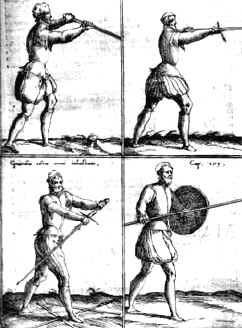 Renaissance
Masters systematized and innovated the study of Western fighting skills
into sophisticated, versatile, and highly effective martial arts eventually
culminating in the development of the penultimate weapon of street-fighting
and dueling, the quick and vicious rapier. Through
experiment and observation they discerned that the thrust traveled
in a shorter line than the arc of a cut and against an unarmored foe
would strike sooner and reach farther. The
rapier was developed along these principles. Thrusting was already
well known in Medieval combat and the new style of foyning fence was
thus not any “evolution”, but rather an adaptation to
a changed environment. Rather
than for war or battlefield, the slender, deceptive rapier was a personal
weapon for civilian-wear and private quarrels.
It was first designed for the needs of back-alley encounters
and public ambush. Indeed,
it was the first truly civilian weapon for urban self-defence developed
in any society. It rose from practical tool, to popular “gentleman's
art”. Elegant in its lethality, it represents one of
the most innovative and original aspects of Western martial culture
and one with no parallel in other cultures. While never eclipsing
cutting swords entirely, as a specialized weapon for personal single-combat,
it was unequaled for almost 200 years until the widespread adoption
of effective and reliable handguns.
Renaissance
Masters systematized and innovated the study of Western fighting skills
into sophisticated, versatile, and highly effective martial arts eventually
culminating in the development of the penultimate weapon of street-fighting
and dueling, the quick and vicious rapier. Through
experiment and observation they discerned that the thrust traveled
in a shorter line than the arc of a cut and against an unarmored foe
would strike sooner and reach farther. The
rapier was developed along these principles. Thrusting was already
well known in Medieval combat and the new style of foyning fence was
thus not any “evolution”, but rather an adaptation to
a changed environment. Rather
than for war or battlefield, the slender, deceptive rapier was a personal
weapon for civilian-wear and private quarrels.
It was first designed for the needs of back-alley encounters
and public ambush. Indeed,
it was the first truly civilian weapon for urban self-defence developed
in any society. It rose from practical tool, to popular “gentleman's
art”. Elegant in its lethality, it represents one of
the most innovative and original aspects of Western martial culture
and one with no parallel in other cultures. While never eclipsing
cutting swords entirely, as a specialized weapon for personal single-combat,
it was unequaled for almost 200 years until the widespread adoption
of effective and reliable handguns.
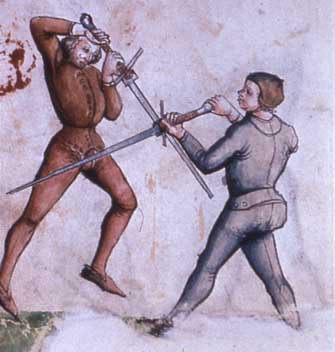 |
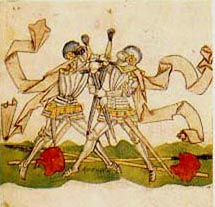 |
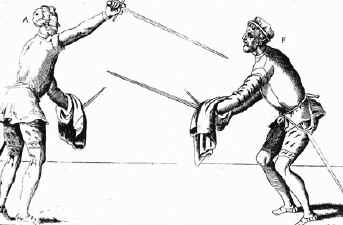 Like
much of progress in Renaissance learning and science, advances in
self-defense were based on what had already been commonly established
for centuries. They were not able to achieve
their progress in a vacuum. There is an obvious direct and discernible
link between the brutal, practical fighting methods of the Middle
Ages and the more sophisticated, elegant Renaissance fencing systems.
No tradition of fighting or methodology of combat exists
by itself. It comes into being due to
environmental pressure as only a processing or refinement of what
existed previously. So it was with the
fencing arts of the Renaissance. They
followed a more than 2,000-year-old military tradition within Western
civilization of close-combat proficiency.
Like
much of progress in Renaissance learning and science, advances in
self-defense were based on what had already been commonly established
for centuries. They were not able to achieve
their progress in a vacuum. There is an obvious direct and discernible
link between the brutal, practical fighting methods of the Middle
Ages and the more sophisticated, elegant Renaissance fencing systems.
No tradition of fighting or methodology of combat exists
by itself. It comes into being due to
environmental pressure as only a processing or refinement of what
existed previously. So it was with the
fencing arts of the Renaissance. They
followed a more than 2,000-year-old military tradition within Western
civilization of close-combat proficiency.
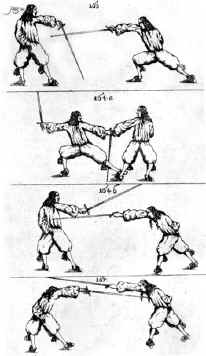 The
techniques developed and taught by the Masters of Defence were not
“tricks” nor merely based only on brute strength.
They were moves they knew worked in combat, that they had discerned,
had named, and had taught to others. But,
to fencers in much later centuries, (bounded by rules of deportment
and the etiquette of convention) these earlier fighting styles (designed
to face a range of arms and armors) would naturally seem less “scientific”.
With the disconnection that occurred between older traditions and
the precise sporting swordplay of later gentlemen duelists, it is
reasonable that the earlier, more dynamic, flexible, and inclusive
methods would incorrectly seem to only be a mix of chaotic gimmicks
unconnected by any larger “theory”.
The
techniques developed and taught by the Masters of Defence were not
“tricks” nor merely based only on brute strength.
They were moves they knew worked in combat, that they had discerned,
had named, and had taught to others. But,
to fencers in much later centuries, (bounded by rules of deportment
and the etiquette of convention) these earlier fighting styles (designed
to face a range of arms and armors) would naturally seem less “scientific”.
With the disconnection that occurred between older traditions and
the precise sporting swordplay of later gentlemen duelists, it is
reasonable that the earlier, more dynamic, flexible, and inclusive
methods would incorrectly seem to only be a mix of chaotic gimmicks
unconnected by any larger “theory”.
Eventually, due to changing historical and social forces, the traditional martial skills and teachings of European Masters of Defence fell out of common use. Little to nothing of their methods actually survive in modern fencing sports today which, based on conceptions of 18th century small-sword combat, are far removed from their martial origins in the Renaissance. Later centuries in Europe saw only limited and narrow application of swords and traditional arms, only some of which survived for a time to become martial sports.
|
|
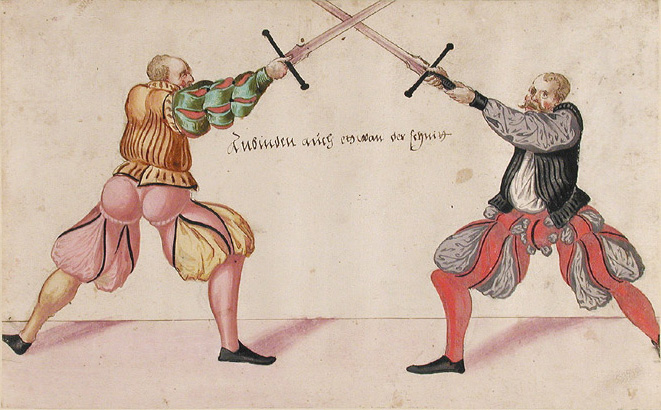 |
Modern
Research & Practice
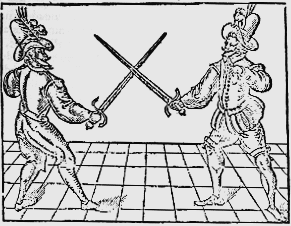 In
a sense, our European martial culture is itself something still very
much with us today. But it now bares little resemblance to its Renaissance
heritage. The technological revolution
in Western military science which swept the 18th century left behind
the old ideas of an individual, armored warrior trained in personal
hand-to-hand combat. It was replaced with the new “Western Way
of war” utilizing ballistics and associated organizational concepts.
This very approach itself, emphasizing more and more a technical,
mechanical, and industrial method of armed combat, is
the Western martial “tradition” now. Indeed, it is this
very martial way that is now the model for all modern armed forces
the world over. In a sense, to see a modern
aircraft carrier, fighter squadron, or armored battalion is very much
the embodiment of a continuing and ever evolving European martial
tradition.
In
a sense, our European martial culture is itself something still very
much with us today. But it now bares little resemblance to its Renaissance
heritage. The technological revolution
in Western military science which swept the 18th century left behind
the old ideas of an individual, armored warrior trained in personal
hand-to-hand combat. It was replaced with the new “Western Way
of war” utilizing ballistics and associated organizational concepts.
This very approach itself, emphasizing more and more a technical,
mechanical, and industrial method of armed combat, is
the Western martial “tradition” now. Indeed, it is this
very martial way that is now the model for all modern armed forces
the world over. In a sense, to see a modern
aircraft carrier, fighter squadron, or armored battalion is very much
the embodiment of a continuing and ever evolving European martial
tradition.
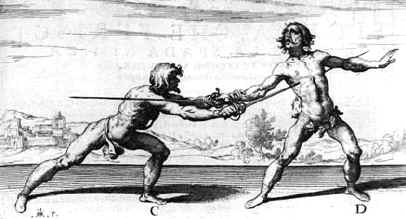 From
the time of the ancient Greeks onward Western Civilization has always
been a source of uniquely resourceful ideas and specialized innovation.
For better or worse, the same technical ingenuity that was
applied to classical arts and sciences was directed equally towards
the weapons of war and skills of battle. In
short, the Western world's contributions to martial arts are far-ranging
and far-reaching. Modern boxing, wrestling,
and sport fencing are the very blunt and shallow tip of a deep history
which, when explored and developed properly, provides a link to traditions
which are as rich and complex as any to emerge from Asia.
Today, as more and more students of the martial
arts of Renaissance Europe ("MARE") earnestly study the subject they
are recovering this heritage and reclaiming it from myth, misconception,
and fantasy. This is not about
costumed role-play or theatrical stunt shows, but scholarly research
combined with genuine martial arts training.
As a result a more realistic
appreciation of our Western martial culture is now emerging full force.
From
the time of the ancient Greeks onward Western Civilization has always
been a source of uniquely resourceful ideas and specialized innovation.
For better or worse, the same technical ingenuity that was
applied to classical arts and sciences was directed equally towards
the weapons of war and skills of battle. In
short, the Western world's contributions to martial arts are far-ranging
and far-reaching. Modern boxing, wrestling,
and sport fencing are the very blunt and shallow tip of a deep history
which, when explored and developed properly, provides a link to traditions
which are as rich and complex as any to emerge from Asia.
Today, as more and more students of the martial
arts of Renaissance Europe ("MARE") earnestly study the subject they
are recovering this heritage and reclaiming it from myth, misconception,
and fantasy. This is not about
costumed role-play or theatrical stunt shows, but scholarly research
combined with genuine martial arts training.
As a result a more realistic
appreciation of our Western martial culture is now emerging full force.
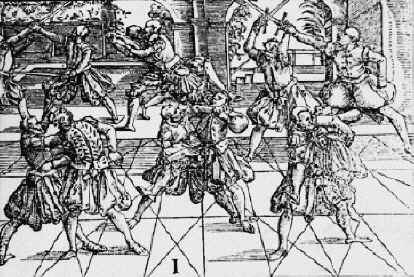
See
also
Introduction to Renaissance Martial Arts Literature
and
|
|
|||
|
|
|||
|
|||